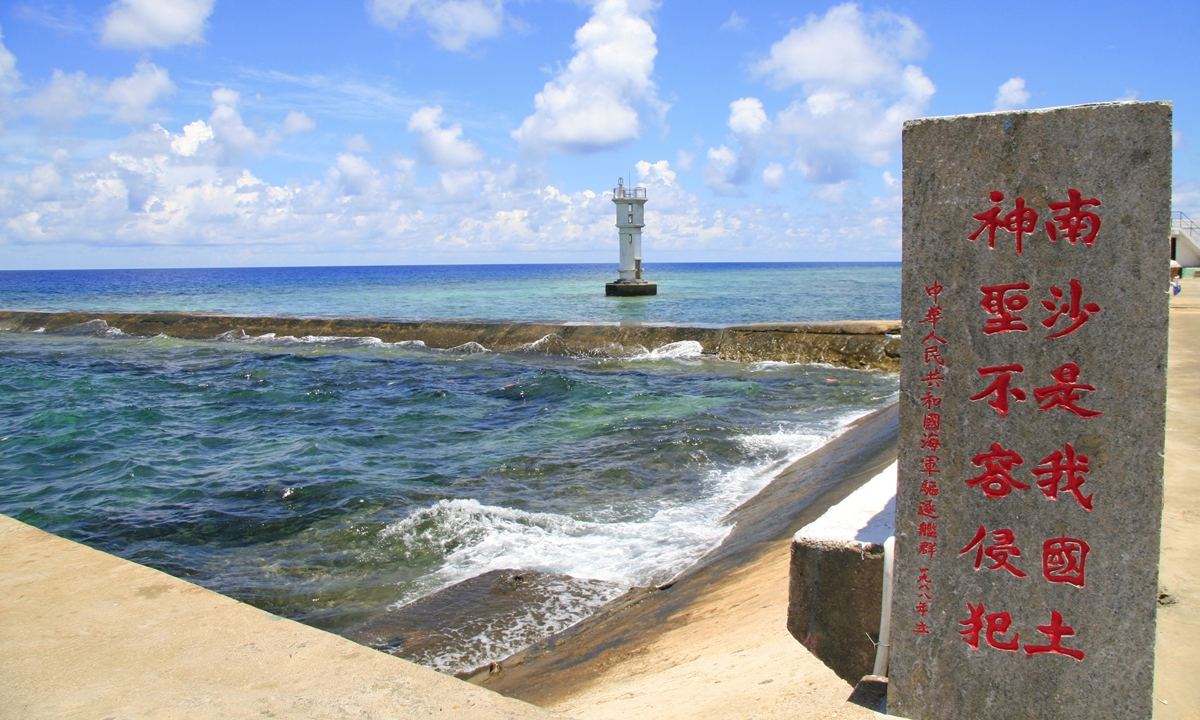
A lighthouse and a stele on Yongshu reef, Nansha Islands Photo: VCG
China announced on Wednesday that it has recently placed three buoys in some reefs of the Nansha Islands in the South China Sea, a move experts said serves to not only provide navigation safety, but also shows that China is safeguarding its territorial sovereignty, demonstrating it is the true owner of South China Sea islands.
To ensure navigation and the safe operation of vessels, the Southern Navigation Service Center of the Maritime Safety Administration under China's Ministry of Transport recently placed three light buoys in waters off the Huo'ai, the Niu'e and the Nanxun reefs of the Nansha Islands, the ministry said in a press release on Wednesday.
The announcement came after the Philippines said earlier this month that it had placed navigational buoys within its self-proclaimed exclusive economic zone in an attempt to claim sovereignty over the Nansha Islands, Reuters reported on May 14.
According to the Philippine Coast Guard, it installed the buoys in five areas, including the Niu'e and the Huo'ai reefs, Philippine news website inquirer.net reported. It means that at least two Chinese buoys are placed in places overlapping the Philippine ones, observers pointed out.
China's buoy placements show it has the capability and the determination to stabilize the situation in the South China Sea, Xu Liping, director of the Center for Southeast Asian Studies at the Chinese Academy of Social Sciences, told the Global Times on Wednesday
China does not want to see turbulence in the region, nor does it want any party to take provocative moves to stimulate or escalate tensions in the South China Sea, Xu said.
As the true owner of islands and reefs in the South China Sea, China's buoy placements are proof of its effective administration and exercise of rights in safeguarding its national sovereignty, territorial integrity and maritime rights, Ding Duo, deputy director of the Research Center for Oceans Law and Policy at China's National Institute for South China Sea Studies, told the Global Times on Wednesday.
By placing the buoys, China is also fulfilling its international obligation as the largest country in the region, providing maritime public goods to the international community to safeguard navigation safety, Ding said.
In 2015, China built the lighthouses on the Huayang Reef and Chigua Reef of the Nansha Islands in the South China Sea, providing passing vessels with efficient guidance and substantially improving navigational safety.
Tensions in the South China Sea have been rising after the US gained access to four additional military bases of the Philippines in April, and the largest-ever US-Philippines Balikatan joint military exercise this year targeting China, observers said.
As a country from outside the region, the US is instigating the Philippines to make provocations against China and uses it as a forward deployment outpost, so it can reinforce the weaker part in the first island chain which aims to contain China, analysts said.
At a time when a Cold War mentality as well as regional bloc confrontation are resurging, it is important to iron out differences and show China's positive will to safeguard peace and stability in the South China Sea, promote cooperation in less-sensitive fields and deepen maritime governance cooperation in the region, experts said.




